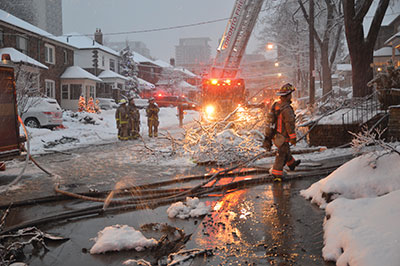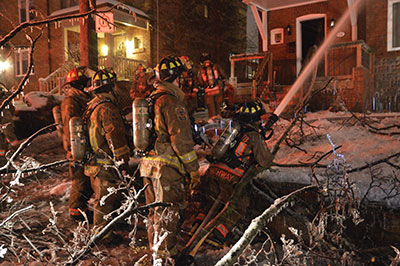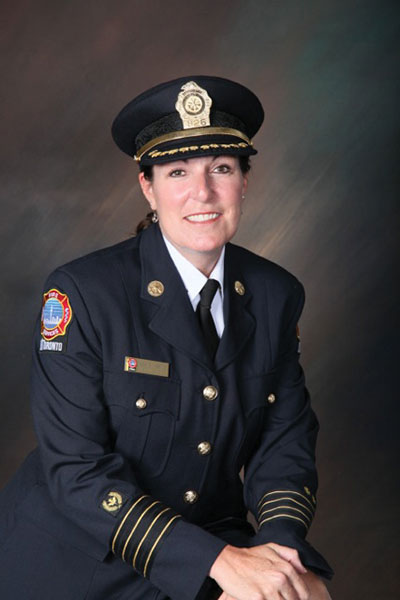
Features
Hot topics
Incident reports
Ice-storm response
The ice storm that walloped southwestern Ontario in late December wreaked havoc on highways, residential streets and the power grid.
February 26, 2014
By Debbie Higgins
The ice storm that walloped southwestern Ontario in late December wreaked havoc on highways, residential streets and the power grid. In Toronto, the epicentre of the storm, the 10 to 30 millimetres of ice that fell between 22:00 on Saturday, Dec. 21, and 07:00 on Sunday, Dec. 22, caused power outages for more than 300,000 people – that’s twice the population of Prince Edward Island.
 |
|
| In addition to fires, Toronto Fire Services responded to 316 carbon monoxide calls, 813 medical calls, 128 rescues, 102 vehicle incidents and 538 check calls during and after the Dec. 21-22 ice storm. Photos by Larry Thorne
|
Between 07:00 on Dec. 21 and the end of the spike in calls at 07:00 on Dec. 25, Toronto Fire Services (TFS) responded to 5,534 incidents, with 9,655 vehicle responses. In the same period in 2012, there were just over 1,200 incidents. Forty-two per cent of the calls during the storm – or 2,351 – were for downed wires. Of the 668 fire calls in this period, nine were multiple-alarm fires, and an additional 15 were working-fire responses, all made more difficult because of extreme weather conditions. There were 316 carbon monoxide calls, 813 medical calls, 128 rescues, 102 vehicle incidents and 538
check calls.
Two of the fire calls resulted in fatalities, both through the night on Dec. 24-25. The first was a male victim who died in a car fire; the vehicle was fully involved when crews arrived. The man was a resident of the building at which the car was located, which was without power at the time of the incident. The second incident was at a four-storey residential building that had full power, so there was no indication that the fatality was storm related.
Unlike the rain storm on July 8 that hit Toronto with no warning and caused flash floods – TFS responded to 1,185 calls in 24 hours – the freezing rain had been predicted for days in advance of the pre-Christmas ice storm.
The first update from Toronto Hydro was received very early on Sunday, Dec. 22 (just after midnight on Saturday, Dec. 21), indicating increasing power outages across the city, which were expected to persist as ice continued to form on power lines and tree branches.
At the time, there were about 8,500 customers without power, and Toronto Hydro was projecting that power could be restored in 12 to 16 hours. By 03:00 on Dec. 22, the number of customers without power had increased to 50,000; a few hours later the utility declared a Level 3 emergency, the highest level emergency. At the height of the emergency, the number of Toronto Hydro customers without power reached almost 300,000.
Of course, emergencies never seem to coincide with regular office hours so the initial storm response started with a conference call made very early Sunday morning from the homes of department heads and the most senior city staff, as the city tried to establish the extent of the damage from the ongoing storm and potential timelines for re-establishing normal operations. It became clear early on that this was a storm of enormous magnitude, and would require the co-operation of almost every city department to ensure citizens remained safe and warm.
Within a few hours the city had opened its Emergency Operations Centre (EOC), but not without tremendous difficulty. The building that houses the EOC was one of the structures without power, meaning it could not be used for this vital operation. The back-up EOC location was also without power, and did not have generator back-up. As the primary EOC location is also the Toronto Police primary 911 call centre, and the city’s main data centre location, there was a significant amount of work that had to occur in a very short time to keep the city systems operational.
By late morning on Sunday, Dec. 22, a temporary EOC location had been devised at Metro Hall. Given that none of the rooms was big enough to house the entire operations, planning, logistics, finance and administration teams, the group split up over several office areas and communicated through regular conference calls – and a fair amount of walking up and down the hallways. Updates from the EOC on the status of operations of city divisions were sent out regularly to ensure that division heads, senior city staff and elected officials remained up to date on the status of the situation.
It is important to note that the ice storm was not a fire emergency; it was a hydro emergency more than anything (there was no state of emergency declared), but as we all know, when disaster strikes, the fire department is almost always called to do the heavy lifting, at least in the early stages.
TFS senior staff started working on our longer-term emergency plan early Sunday afternoon. Fire Chief Jim Sales worked with the mayor’s office, the city manager and other elected officials. A deputy chief and a division commander had been dispatched to the EOC for the start-up of operations, and the deputy chief of operations was at headquarters to oversee the activities of the department until the EOC could take over. I pulled the short straw and was assigned the first overnight shift in the EOC, from 22:00 on Dec. 22 until 07:00 on Dec. 23. However, once everyone became aware of the situation, all TFS senior staff became involved in the response, regardless of EOC assignments or scheduling.
The loss of hydro also hit TFS. By the time the freezing rain stopped late on Sunday, 19 fire halls had lost power, which also meant they were without heat. While fire crews were busy responding to emergency calls, staff from our heavy urban search and rescue team began to distribute generators and portable heaters to as many halls as possible. Mechanical staff were called in for the duration of the outage to go from fire hall to fire hall to start up and refuel generators.
Not surprisingly, most of the calls to which TFS responded in the first hours of the storm were related to downed wires. Crews responded as quickly as possible, in most cases working to make each situation safe so they could move on to the next location. Our communications centre kept a list of all wires-down locations to pass on to Toronto Hydro, as it was having difficulty keeping up with the volume of calls.
The first update from our communications centre came at 18:00 hours on Dec. 22, by which time staff had a handle on the volume of calls and were able to start generating some statistics. At the time, they reported that between 16:00 on Dec. 21 (the night of the storm) and 06:00 on Dec. 22, TFS had responded to 1,200 calls, almost 800 of which occurred between midnight and 06:00. Almost 500 of those calls were related to downed wires, but there were also a significant number of alarm ringing calls and elevator-rescue calls as the power shut down across the city.

|
|
| During the ice storm that hit southwestern Ontario in late December, fire crews in Toronto responded to 668 fires in just four days. Nine of those fires were multi-alarm calls.
|
It became obvious that TFS would not be able to keep up with the call volume, and in the early hours of Dec. 22, our single-truck response protocol was activated. This protocol allows TFS to treat fire alarm ringing calls and any others deemed appropriate as if they are check calls (depending on the information available at the time of the call), so that we can respond to more incidents in a more timely fashion. Even with that protocol in place, by 15:00 on Dec. 22 we had more than 150 responses pending, waiting for a truck to be available. The number of pending calls fluctuated for many hours, and it wasn’t until 04:00 on Dec. 23 that crews responded to the last pending call, the single-truck response protocol was terminated, and we returned to normal dispatching procedures. (TFS did not call for mutual aid; all surrounding municipalities were dealing with similar circumstances and most calls were make-safe situations.)
As the city began to wake again the morning of Dec. 23, TFS again began to generate lists of pending calls, but not to the extent as in the previous 24 hours.
Monday, Dec. 23, brought new challenges, as many staff returned to workplaces in civic centres and other locations that were still without power. Last-minute arrangements had to be made to accommodate staff (particularly those in fire prevention, who tend to work in civic centres) in offices other than their own until power could be restored at their base locations, which generally did not happen until after Christmas.
By the end of the day on Dec. 23, and through the night to Dec. 24, TFS had largely caught up on all responses, and had offered about as much assistance to Toronto Hydro as was possible. By 15:00 on Dec. 24, senior staff of TFS were no longer staffing the EOC, but remained on call to assist should the need arise. Toronto Hydro continued the painstaking process of restoring power, which was not entirely complete until the first week of January. The city in general continued in emergency mode until after the new year, operating warming centres for citizens during the day and at night, and providing as much assistance as possible through wellness checks carried out by police, fire and shelter, housing and support.
While the majority of the calls to which TFS responded throughout the emergency were related to wires down, it became evident that the loss of power – especially within a few days of Christmas and during a particularly cold spell – was causing citizens to disregard fire-safety messages, resulting in a number of significant fire incidents. On Dec. 23, TFS issued a press release stressing ice-storm related fire-safety tips, largely focused on candle safety, cooking, heating and messages related to carbon monoxide, which was increasingly becoming a problem as residents looked for ways to provide heat to their homes. These fire-safety messages continued to be promoted through daily press conferences held by the mayor and other senior staff. In addition, TFS communications staff used social media to send out safety messages.
While the ice storm emergency is over, southwestern Ontario was – when this was written – in the midst of what weather experts said may have been the coldest winter in 25 years. It appeared that all emergency services need to be prepared for extreme weather events of all types, as meteorologist and climatologists say they are likely to increase in frequency. Several valuable lessons were learned through this ice-storm experience, as unlike the flood of July 2013, there was a prolonged period of higher-than-normal call volumes and responses to non-fire-related events.
Good emergency planning by the municipality and the fire service is required to ensure we continue to meet our goal of service to the public no matter the circumstances.
Lessons learned
|

|
Debbie Higgins is a deputy chief with Toronto Fire Services, responsible for fire prevention and public education. Debbie previously held the portfolio of staff services and communications, following her promotion to deputy in 2010. Prior to this, she spent 11 years as an executive officer for TFS, with responsibility for special projects. Debbie previously worked with the City of Mississauga as a business planner, where her work included strategic projects for the fire department. Before joining the municipal sector, Debbie spent five years working as a consultant. She has a degree in applied geography from Ryerson University and a certificate in business from McMaster University. She is completing her diploma in public administration through the University of Western Ontario. Contact Debbie at dhiggin@toronto.ca and follow her on Twitter at @debbiejhiggins
Print this page